Photo writeup: Chandrayan-3
Musings by Shekhar Nambiar
India’s space forays have developed into an advanced and focused program with cooperation across the globe. It is a pragmatic approach. What’s more, it is non-partisan and has all-round support within our borders.
If the rockets are built in Israel and satellites partially assembled indigenously, ISRO has developed capability in cryogenic engines with mastery over rocket launches.

More to follow
This July, India successfully placed in orbit six satellites, among them one for Singapore, through the PSLV-C56 rocket. ISRO’s chief S. Somanath said there will be four more missions this year.
India is placing satellites in orbit with increased frequencies and is now pursuing advanced space exploratory missions.
Apollo missions
Two recent rocket launches, the last one on Saturday, from our own Cape Canaveral, Sriharikota, takes many of us from the sixties and seventies’ generations to the Apollo series rocket launches.
Also read: China is watching
Among the several Apollo missions that launched rockets into outer space, it was Apollo 11 that created history in man’s quest for conquering the frontiers of space science as the landing craft Eagle made the moon landing.
Neil Armstrong became the first human to set foot on moon on that historic day on July 21, 1969, after he helped pilot the lunar vehicle to land at the Sea of Tranquility.

A giant leap
The mission commander’s words ring in ears to this day. On setting foot on the moon 54 years ago to the month, Armstrong is believed to have said”That’s one small step for man. One giant leap for mankind.”
As children, perhaps most from that era, listened to live radio clips of the moon landing by Neil Armstrong and his associate astronaut even as their third co-astronaut Michael Collins circled the moon waiting, did not understand the full import of space history created by Armstrong’s crew.
Also read: When it rains, it pours
Only children who followed the moon and space missions closely perhaps understood the significance and importance of the development. Some of us city-dwellers were fortunate to have viewed live film clips, documentaries, and models of the lunar craft displayed by US missions overseas that made a lasting impression, as history was created up above.
Our own fledgling space program then was confined to a small equatorial space launch pad at Thumba near Trivandrum and a few space tracking stations across the country.
Michael Collins, command module pilot, had a key task on hand, that of circling the earth’s satellite planet as his commander and fellow astronaut went about their chores on the moon, including to collect moon rock samples and take photographs of earth and the wide-open space.
Collins had to ensure the accurate docking of the landing craft on its way up to take them out of lunar orbit and prepare for the journey back home. The return journey had to be perfect for the trio’s craft to splash down in the Pacific Ocean.
Also read: Many Voices One World
Everything about the mission went well with clockwork precision. And so too with other NASA missions until the ill-fated Challenger and Columbia shuttles perished taking the lives of several crew members on both missions.

Tragedies in space
The tragedies shook the American space program. It certainly broke the inconceivability myth. The February 2003 space mission Columbia met with a fiery end on its re-entry into earth’s atmosphere high above Texas and Louisiana states. Debris and bodies were recovered strewn over a large area.The crew included Indian American astronaut Kalpana Chawla.
Also read: What the monsoon means to me!
Earlier on January 28, 1986, the Challenger space shuttle exploded over the Atlantic Ocean minutes after lift off from NASA’s Kennedy Space Center at Cape Canaveral in Florida, killing all seven crew aboard. A high visibility crew member was a New Hampshire school teacher, Christa McAuliffe, scheduled to undertake classes from orbit to impress on children in the US the need to honour teachers as also to inspire them for careers in hi tech areas.

Cold War ills
America’s space shuttle programs decelerated somewhat following the accidents.
Priorities also changed thanks to the end of cold war compulsions. The neck-and-neck race with the Soviet space program, which had different priorities, had ended. And, to some extent, it was no longer competition or one-upmanship that determined priorities.
Also read: A historic win at Roland Garros
The accelerated US space program and the Apollo missions were all put in place to offset the early advantages of the Soviet space research and program, including the Sputnik successes, if their propaganda machines were to be believed.

Star Wars
The intense rivalry and the looming threat of doomsday from a nuclear conflagration among the two super powers brought the US to look at space as the ultimate frontier for the defence of the country. As a result, the world witnessed the US prepare for a Strategic Defence Initiative (SDI), putting millions and millions of dollars for a shield to protect them from a real or imagined threat from the Soviet Union. Not a day passed without the mighty US Information mill churning out reams and reams of paper detailing how the SDI would effectively block a Soviet attack on America.
Final frontier
While the Reagan-initiated SDI was dumped unceremoniously, and with the Cold War having ended, the question asked is cannot and shouldn’t space research look at the more pressing problems the world as a whole faces today?
Global warming and climate change, among other areas, are real threats the earth faces. The focus of space science and research ought to be on these. Instead of spy satellites high above prying on us, it is the moment propitious to look at ways to mitigate the more complex of earth’s problems first.
It is time that we gave our Living Planet a closer look!
Also read: Parliament, Sengol& Nehru




